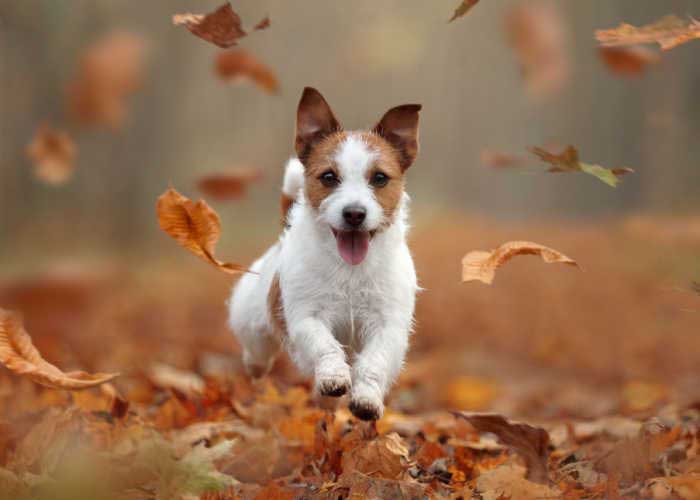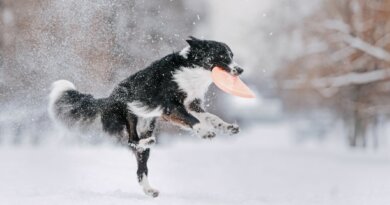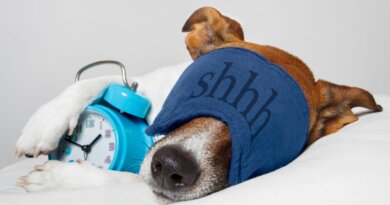Chasing After Moving Things in Dogs – Top Dog Tips
Wondering why your dog chase after cars, bikes, and all the like?
There’s no denying that dogs love to run.
As a matter of fact, they were born to run!
Running makes them happiest that they could probably gallop around all day.
Although each breed has a unique body structure, all dogs have certain traits in common that make them such speedy sprinters.
I bet you’ve already witnessed how fast your pooch could take off running during a backyard escape or on a game of tag.
Even most dog owners have stopped to admire their furry friends’ grace and speed when zooming around at some point or another.
While zoomies are only natural in dogs and shouldn’t harm them in any way, this doesn’t mean we’ll just let them run in the wind.
What if they start chasing cars? Or chase cats down the street?
Now, that’s concerning.
In this article, we will try to understand what incites dogs to chase moving things and how to curb that impulse before they get hurt.
Chasing After Moving Things in Dogs
Dogs love to chase anything and everything. if it moves, then they’ll go after it.
This behavior may be caused by the fact that rapidly moving objects set off a dog’s innate desire to hunt—the same instinct that drives them to chase after cats, bunnies, and squirrels.
Chasing comes naturally to most dogs, especially among sighthounds and herding breeds.
Sighthounds of all sizes, from Afghan Hounds to Whippets, were bred over thousands of years particularly to chase down prey.
These dogs are exceptional chasers because of their sharp vision and awareness of their surroundings.
Due to their natural tendency to round up livestock, herding dog breeds are also more likely to chase runners and skateboarders.
Cat Chasing
Although they can coexist in complete harmony, dogs and cats occasionally experience some conflict.
Cats are lone hunters who prefer independence, whereas dogs are pack animals who love company.
When playing with other puppies, dogs frequently chase them, which cats may interpret as a threat.
If your dog was bred for chasing or herding, he chases a cat simply out of instinct.
Some dogs who chase cats do so out of pure play—in these instances, they chase cats somewhat like chasing balls that have been tossed for them.
So, as soon as you notice this behavior in your dogs, make sure to let them see cats not as toys, but rather as companions.
Car Chasing
Some dogs enjoy chasing fast-moving things, including cars and other vehicles, which is a very dangerous pastime.
They go in pursuit whenever they spot a car moving in the distance.
Some dogs are so driven that they may even wait by the side of the road or in a ditch, leaping out as the car approaches.
When dogs dart into the road, they often sustain catastrophic injuries or even death—typically, not by the car they are after, but by one passing.
When cars swerve to avoid them and are surprised by their abrupt arrival on the road, they can also result in serious auto accidents.
Even dogs on leashes who are drawn to traffic can cause issues.
A leashed dog may become quite agitated around passing vehicles that he can hurt both himself and his fur parent by running out into the road.
If your pooch displays interest in the motion of the car for the very first time, refocus his attention on you or something else fun to stop him from ever beginning to chase cars.
But because some dogs are just highly driven to chase vehicles, you may consult with specialists or behaviorists to correct this risky behavior.
Leaf Chasing and Shadow Chasing
Dogs who chase after moving objects may develop an obsession.
They see leaves and shadows as something they have to have. So, they keep trying, but never truly succeed.
And since they can’t get it, they keep at it.
To change this behavior, you may engage in activities that encourage calm submission.
Train your dog to respond differently to the objects of their obsession.
Don’t allow him to glance down at any shadows when out for a walk.
Keep him concentrated on the walk. Divert your dog’s interest and never resort to punishments as it will only make matters worse.
Bicycle Chasing and Skateboard Chasing
When chasing cars from behind a fence, one can also start chasing bicyclists or skateboarders who pass the yard.
The rumble on the wheels or the skateboarders’ quick passing can be the cause of the problem.
At the skatepark, perhaps your dog feels the need to lead them.
Barking and chasing skateboarders might put you and your dog in serious trouble.
He may cause someone to fall and get hurt as a result of being startled if he begins to lunge or scare that person on a skateboard.
On the other hand, the speeding bicycle with spinning wheels and the cyclist on it is just too much to resist.
It’s likely that your dog first developed an interest in bicycle wheels by chasing a kid’s bike around the backyard because bicycles come in many sizes.
At the moment, it was cute and funny, but this is a habit that shouldn’t be supported.
As your dog ages, his attention will be drawn to bigger and better bikes.
Young dogs’ joyful disposition is presumably nourished by chasing bikes.
They assume that the game of “chase” has begun because of the moving wheels, the bicycle’s speed, and the fact that it is moving away.
Unfortunately, cyclists may kick your pet viciously to get your dog’s attention and prevent a bite because they are unaware that this could just be a game.
Your dog perceives the moving bicycle differently now because chasing bikes is connected to some degree of terror.
It’s possible that chasing bikes will now be motivated by fear and territory defense.
Worse, they could start chasing people without differentiating who poses a threat and who doesn’t.
Chasing After Humans in Dogs
Every dog has a distinct personality.
While some are outgoing and love interacting with outsiders, others, just like us humans, simply can’t get along with those who are not a part of the group.
For them, there is only one way to get rid of the invasion of their privacy, and that is to chase it away.
Not all dogs do this, but some may dash out into the street and chase mail carriers simply because these guys don’t look or smell familiar.
They perceive strangers as unwelcome intruders posing a threat to their realm.
To protect themselves, they would be forced to chase the trespassers away as these invaders might attack and take what is rightfully theirs.
This can happen when you’re out walking your dog, too.
One minute he’s calm and happy. The next he’s after someone at the speed of light.
How to Train Dogs from Chasing After Moving Things
All is well if your dog drives away a stranger who approaches your house with evil intentions.
He is taking care of your home and keeping you safe as part of his job.
But if that random stranger happens to be the delivery guy dropping off your parcel, then that’s going to be a problem.
To save you, your dog, and strangers an awful lot of stress, you might want to consider enrolling your pet in professional training sessions.
A qualified dog trainer can show you how to control your pup’s chasing impulse before it starts.
But if your pooch has already started chasing things like cars or trucks, don’t chase after him.
It will simply make him think you are playing, which will probably make the chase last longer.
When attempting to teach him not to chase, leashes and rewards are your pals.
Even if your backyard is securely enclosed, practicing keeping your dog on a leash will be beneficial if he tends to go off after birds or squirrels.
Keep him on a leash and show your appreciation with treats.
You can start letting your dog off-leash in your enclosed yard once he learns to focus on you while being leashed, even when there are small animals around.
You’ll be training your dog to develop attention and impulse control by teaching him to remain calm in the face of exciting events and to hold out on getting what he wants until released.
Reward your pet for remaining close to you and ignoring distractions.
Then, practice in surroundings that are progressively more distracting as he gets more confident and can concentrate in the presence of distractions.
Games and Sports for Dogs who Like Chasing
Dogs enjoy chasing so much that it can be particularly difficult to teach them not to.
But instead of suppressing your fluffball’s innate urge to chase, try using it in exercises and activities, such as:
- Fetch: Instead of chasing the squirrels in your yard, your dog can use his natural drive to chase balls and other toys.
- Tug: Dogs who enjoy chasing or who have excess energy will enjoy the game of tug. This also serves as an excellent teaching and practicing tool for impulse control.
- Tag: It can be a fun and lively activity to teach your dog to chase you within your home or in a securely enclosed space. With food or a toy in your hand, back away from your dog to begin the game. Praise him and provide treats whenever he reaches you.
- Hide and Seek: Call your dog’s name from another area of the house. Reward him with plenty of praise and treats when he runs to find you.
If your pooch just loves to chase, you may have him join in lure coursing.
This is a quick and enjoyable sport that tests a dog’s innate desire to pursue prey.
In lure coursing, dogs chase a moving line-mounted mechanical bait (in this case, a plastic bag) to simulate a real hunt.
Sighthounds can do what comes most easily to them – demonstrate their athleticism and ability for pursuing and catching “prey.”
In contrast to lure coursing, which is only open for select breeds over one year of age, fast CAT is open to dogs of any breed and size—even mixed breed dogs are permitted to compete.
Fast CAT is a timed 100-yard race in which dogs pursue a lure (again, a plastic bag) and sprint in the opposite direction of their owner.
FAQs about Chasing After Moving Things in Dogs
Why are dogs chasing after moving things?
Chasing is an instinct in dogs, especially in herding dogs like Sighthounds.
You can reduce it by teaching your dog to develop impulse control and ignore distractions.
Dog activities like fetch and lure coursing both make excellent use of the chasing impulses.
Is it okay to let my dog chase squirrels?
No. Even though your dog has no chance of catching the squirrel and it may seem like a little fun, your dog will be out of control in “chase mode”.
As a result, he poses a threat to both himself and other animals.
Why is the prey drive in dogs so high?
It is typical for a dog to chase after a moving “prey,” almost as if it were a reflex.
Particularly hunting and herding breeds have higher predatory chase drives than other types of dogs.
Chasing After Moving Things in Dogs: Final Thoughts
It can be difficult to train dogs that enjoy chasing objects, but it’s important to keep in mind that this activity is natural.
It is biologically ingrained in them.
Your dog is merely following a perfectly normal instinct and is not attempting to frighten or disturb you.
They could not be any happier than when sprinting after something with their heads towards the wind and paws moving as quickly as possible.
Making sure that they pursue the right things is all that is required.
If your doggo is up to it, you may play games or do sports. These are great ways to channel your dog’s chase into behaviors that are safe and fun for both of you.
READ NEXT: 8 Tips on How to Train a Dog Not to Run Away
Related










